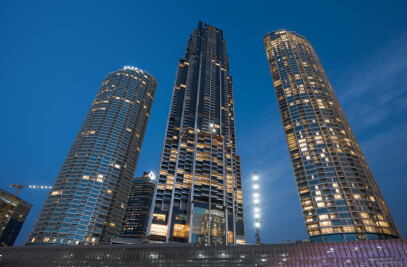Originally where the Indonesian embassy was located, the site was redeveloped in 1986 into Wisma Atria and designed by DP Architects as a 22-storey office tower with a 5-storey commercial podium. The original architecture of Wisma Atria was an introverted atrium-centric, ‘rectilinear-formed’ mall which aligned with contemporary global design patterns for retail buildings of its time and scale.
Over the span of the last 26 years, DP Architects has been involved in the reinterpretation of Wisma Atria where the constant renewal allows the mall to respond to changing societal trends and remain relevant as the definition of retail experience is refined over the years. The practice of retrofitting not only introduces new uses to the building and generates activities suitable to the unban context, it is also a sustainable form of development which gives a building a new lease of life without extensive demolishment and rebuilding. Wisma Atria’s 2004 facelift can be considered the transition point for DP Architects’ retail design direction towards the extroverted urban mall typology found in Orchard Road today. A façade expansion created new visual and functional links between the interior retail space and exterior promenade; the use of glass increased transparency and an external escalator connected upper retail storeys directly to the street – design moves that comprehensively resituated a 1980s retail mall as a street-integrated shopping mall.
The 2012 transformation of Wisma Atria is designed to further augment street visibility and respond to the patterns of human movement through the site. Strategically located between and linking two of Orchard Road’s most prominent corner developments, the new Wisma Atria façade strongly asserts its own unique character and presence. The façade enhancement is also in line with the Urban Redevelopment Authority’s on-going effort to enhance pedestrian connectivity, attractiveness and vibrancy in the Orchard Road Planning Area.
In the new façade design, a high-visibility, faceted glass enclosure performs as a dynamic envelope, articulated to extend 7.5 metres from the original structure at its furthest point. The mall’s architectural progression, like many retail developments on Orchard Road, continues to take place within the contours of the building’s original structure.
The materiality of the new façade is a dialogue between triangulated, faceted glass storefronts and a matte-aluminium finish for the cladding of structure and mechanical systems. To further engage the heavy pedestrian flow generated by the adjacent MRT station, the main entrance was realigned on-centre with the interior circulation and the sunken basement-level programming was sealed off to create a uniform podium linking the street to the mall via a set of grand stairs, which also doubles as a multi-purpose event area.
The new stairs where the new frontage is raised upon like on a pedestal, serves the double purpose of a permanent flood barrier and as a direct pedestrian link to the mall’s new main entrances at the second storey. New ramps were also designed to facilitate movement for the less mobile and to channel pedestrians arriving from the MRT station and flanking malls directly into Wisma Atria’s retail spaces.
The structural concept was based on the goal-post frame structure – with two main support columns spanning across a longer distance, thereby freeing up the intermediate space where the faceted glass façade would be created. This allowed for the faceted glass façade to become the focal point and also maximises the visual porosity to the interior by ridding the main shopfronts of any structural obstruction. Coupled with the use of ultra-clear glass, activities taking place within the mall are clearly visible from street level, which adds an inviting element to the mall frontage.
The intention of the lighting design was to highlight the crystalline structure of the new façade in an elegant and timeless manner. Alluding to the crystal-like form of the façade, some studies of light reflection in gems and crystals were conducted. Careful consideration was given to the mounting locations and beam angles of the light fixtures were varied such that the light was focused effectively along the surface of the glass facets. Together with the internal lighting, the overall lighting solution emphasised the crystalline structure of the glass envelope as well as the aluminium façade, and created a visual sense of depth as one walks down the street.
The lighting design also called for the monolithic grand stairs to be used as a canvas for the play of light. Together with the lighting consultant, moiré patterns were studied, and through the use of scripting software, patterns were generated by overlaying layers of lines extracted from the stair and façade geometry, resulting in a logical and beautiful pattern which achieved some element of perceptive illusion. The final design delivered an intriguing animated ‘light tapestry’ that directs people toward the central Wisma Atria entrance and complements the vibrant Orchard Road nightscape.
The combined redevelopment measures for the mall have been conceived to strongly re-position the Wisma Atria mall in the increasingly competitive Orchard Road retail environment. With the latest iteration of the façade articulation for the mall, it further increases the connectivity between the pedestrian promenade and the internal retail spaces. By manipulating the same structure as a host to a variety of frontages, the mall’s personality has been periodically refreshed to retain a strong customer draw over the span of the last 26 years.

































